Introduction
Generations of gardeners have loved dahlias—and with good reason. Native to Mexico and Central America, these tender perennials burst into bloom in midsummer when other flowers are starting to fade and will keep blooming until the first fall frost. Available in a wide variety of sizes, flower forms and colors, dahlias are popular cut flowers for use in bouquets, vases and floral arrangements.
Dahlias are fairly easy to grow, too, as long as you give them plenty of sun and well-drained soil. You can find varieties that are suitable for growing in back borders, planting along a fence, lining a walkway and containers. These deer-resistant perennials grow in zones 3-10. In zones 3-7, dahlias should be lifted in the fall and stored indoors over winter.
How Many Types of Dahlias Are There?
Plant breeders are introducing new dahlias every year, and today’s gardeners have thousands of dahlia choices. With so much variety, how do you select the best dahlias for growing in your garden or patio?
Start with considering the space you have for growing dahlias. Dahlias can range in size from the large Dinnerplate Dahlias that sometimes grow 60″ tall, to the smaller Border Dahlias that grow just 18″ tall. If growing dahlias in containers, several types are suitable, especially Patio Dahlias.
Next, consider how you want to use your dahlias. While dahlias are very showy and colorful garden plants, some are top choices for cut flowers, and others are favorites for attracting pollinators. If your goal is growing dahlias for cut flowers, then some dahlia types are better choices than others.
Finally, consider your preferences in flower form, size and colors. Dahlia flowers can range in size from 2-10″ across and are available in an array of colors, including bicolors, and forms, including double, cactus and anemone.
Dahlia Varieties
To help choose the best dahlias to grow in your garden, some of the most popular dahlia types are described below.
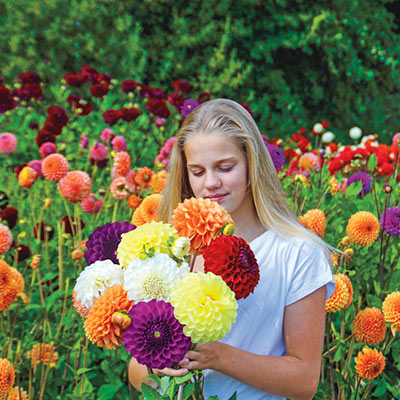
1. Ball Dahlias
One of the most recognizable types of dahlias, Ball Dahlias get their name from their distinctive, orb-shaped to slightly flattened, globed-shaped blooms. The tightly rolled petals give the flowers a very neat, honeycomb-like pattern. They look like brilliant balls of color when they start blooming in the garden.
Ball Dahlias are available in an array of colors, including white, yellow, pink, purple and red. Very uniform in size and up to 5 ½” across, the showy, eye-catching flowers are supported on strong, thick stems. Easily lasting five days as cut flowers, they’re excellent for mixed floral arrangements. Ball Dahlia plants grow 36-48″ tall.
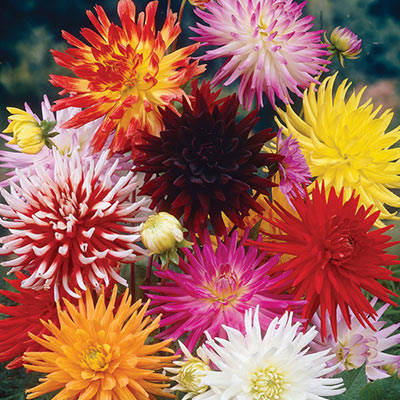
2. Cactus and Fimbriata Dahlias
Long, twisted and curled petals give Cactus and Fimbriata Dahlias a unique look. Available in an array of colors, including white, yellow, red, pink, purple and bicolors, they add plenty of pizzazz to the summer garden.
Cactus Dahlias feature narrow, pointed or spiky petals that are up to 7″ long. Fimbriata Dahlias are also all about the petal shape and feature fringed petals. Cactus and Fimbriata Dahlias are favorites for cut flowers because they add plenty of excitement for bouquets and fresh floral displays. The plants grow up to 40″ tall.
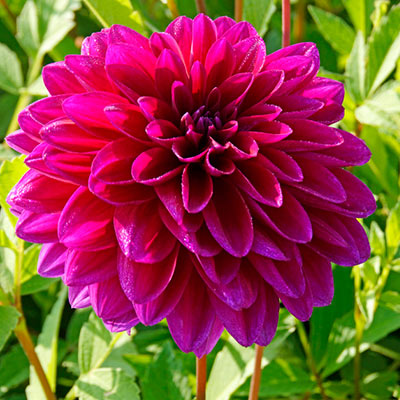
3. Decorative Dahlias
A very large and popular type, Decorative Dahlias offer a wide range of colors and bloom sizes. With broad, flat petals, fully double flowers and no central disc, Decorative Dahlias are very showy and often quite large. The flowers are sometimes 6″, 8″ or even 10″ across. They’re impressive in cut-flower arrangements and bouquets.
Decorative dahlias may be informal with wavy petals in an irregular arrangement, or formal, with petals spaced in an even arrangement. Flower colors may include white, yellow, pink, purple, red or other hues. With their stocky growth habit and strong stems, they’re favorites for cutting gardens as well as perennial borders and even large containers. Depending on the variety, Decorative Dahlia plants may grow more than 40″ tall.
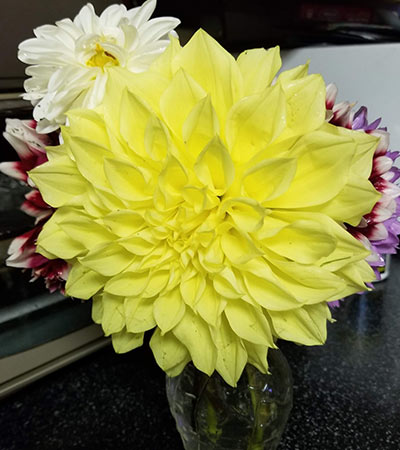
4. Dinnerplate Dahlias
Some of the most impressive dahlias available, Dinnerplate Dahlias feature the largest flowers of any dahlia type. As their name implies, the flowers are as big as dinner plates. The flowers can range from 6-10″ across and come in so many colors, including red, pink, lilac, white, bicolor and more. Grouped together, Dinnerplate Dahlias make impressive cut-flower displays. Because of their bloom size, they’re often featured as a single cut flower in a vase. This also makes the flowers great for gifting.
Dinnerplate Dahlia plants can grow quite large, usually 36-48″ tall, and sometimes taller. Because of their large flowers, the plants require staking for support. Gardeners often plant Dinnerplate Dahlias in the backs of perennial beds, near a building or against a fence.
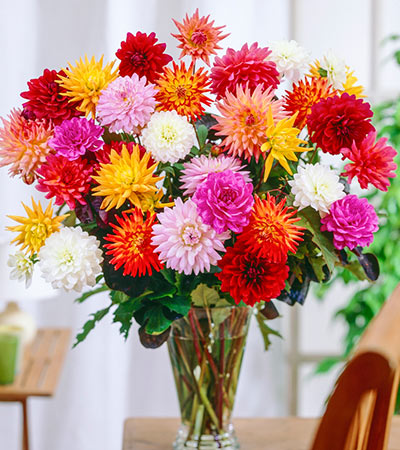
5. Karma Dahlias
Although fairly new to the dahlia world, Karma Dahlias are fast becoming a must-have for cut-flower gardens. These gorgeous, showy dahlias were developed by Dutch hybridizers specifically for the cut-flower market.
Karma Dahlias feature super strong, straight stems and big flowers, often 4-5″ across, but sometimes up to 8″ across. They’re available in a wide range of shimmering hues that are nearly iridescent. They’re excellent for seasonal bouquets and cut-flower arrangements. The robust plants usually grow about 48″ tall.
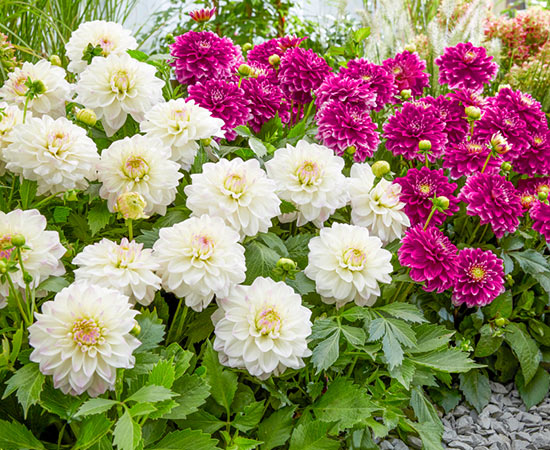
6. Patio and Border Dahlias
A top choice for lining walkways, growing in containers or planting in front borders, Patio and Border Dahlias are smaller in size but still loaded with flower power. Growing 12-18″ tall, these compact plants produce flowers for months, and they don’t require staking.
Patio and Border Dahlias bloom profusely, and the flowers often reach 4″ across. Available in an array of colors, they put on quite a floral display in sunny gardens and containers. Like other dahlia varieties, they make excellent cut flowers. Keep in mind though that they have shorter stems than their larger cousins, so they’re suitable for table-top displays and smaller arrangements.
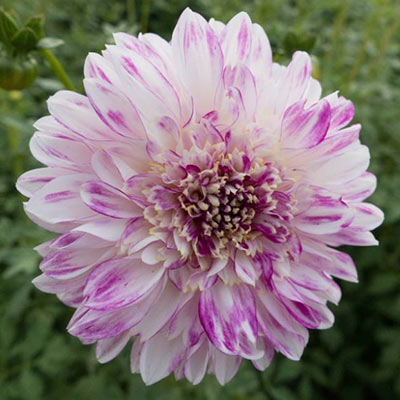
7. Powder-Puff Dahlias
If you’re looking for something a little different, Powder-Puff Dahlias offer an eye-catching form. Sometimes called Anemone Dahlias, Powder-Puff Dahlias feature a ring of large ray florets circling fluffy, puffy central discs. The flowers often reach 5″ across and sometimes a bit larger. Available in an array of colors, and often bicolored, Powder-Puff Dahlias are popular grouped together in bouquets or mixed with other flowers.
Powder-Puff Dahlia plants often grow about 36″ tall and produce plenty of flowers over a long season. Their open flower form makes them especially attractive to pollinators.
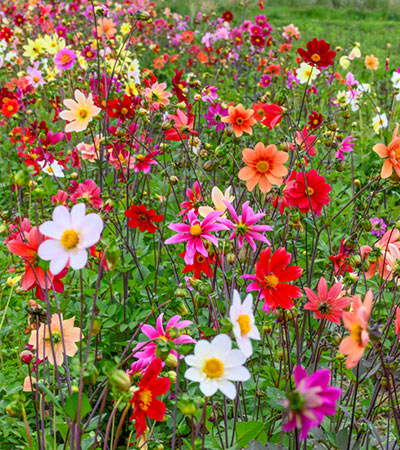
8. Single-Flowered Dahlias
Charming and very attractive to pollinators, Single-Flowered Dahlias feature a solitary row of either flat or slightly recurved ray florets surrounding a central disc. Reaching 2-5″ across, the daisylike flowers are available in a wide selection of colors including bicolors.
While the plant height can vary with the variety, many Single-Flowered Dahlias grow about 24″ tall and are suitable for containers. Whether growing in the garden or as cut flowers in a vase, Single-Flowered Dahlias are a wonderful complement to other late season perennial flowers.
Conclusion
The various flower forms, colors and sizes make dahlias a joy to grow. If you’re like most gardeners, you’ll make room for several different varieties of these cheerful flowers in the garden or on the sunny patio. And, you’ll cut some of these beauties and display them indoors or on the patio table—or you’ll share them with others.
Part of the joy of dahlias is browsing the choices and choosing your favorites. You can browse our full collection of dahlias for sale and use our selection tool to find the perfect variety for you!
While dahlias are easy to grow, to get the most out of your dahlias, check out our guide on planting, caring for, and growing dahlias.

